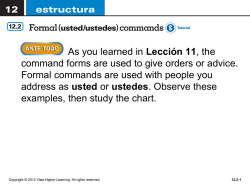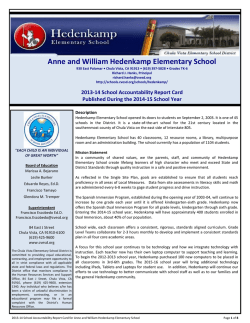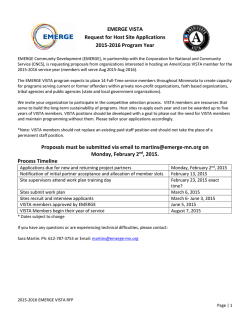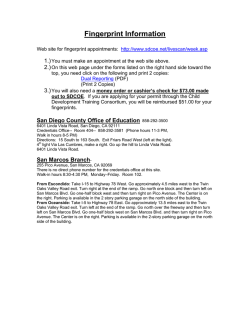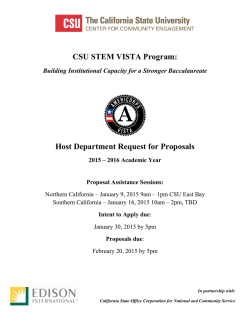
WalkSanDiego engaged the community and
POLICY-RELATED ACTIVITY In Chula Vista,WalkSanDiego conducted a variety of activities to impact policies through planning efforts as well as engage the community to enhance walkability throughout the City with a particular focus on the Southwest region of the City that has a high amount of missing infrastructure and many low-income, underserved residents.The activities discussed below include key planning activities related to policy that WalkSanDiego influenced in the City of Chula Vista. WalkSanDiego assisted in the development of the Pedestrian Master Plan (PMP) by serving as a PMP Working Group Member, expanding community input by conducting PMP surveys during other community activities WalkSanDiego was engaged in, and advocating for a plan that supports walkability and pedestrian improvements. WalkSanDiego participated in a 3-day workshop to prepare a Pedestrian Safety Action Plan to document current practices and policies, while also identifying areas for improvement to create a more walkable city. This plan provided a resource for the more extensive and formal development of a Pedestrian Master Plan. WalkSanDiego reviewed the plan for a downtown Chula Vista “Urban Core” and provided feedback to City staff and Council to ensure guidelines supported walkability. WalkSanDiego participated in the pre-plan community building ‘Southwest United in Action’ project and a series of three southwest Chula Vista urban design workshops as a technical advisor and promoting resident attendance at meetings. WalkSanDiego now serves on the Southwest Working Group to develop a plan for the area. WalkSanDiego reviewed plans and provided technical assistance to the HEAC Manager who serves on the RAC to promote walkable development in the City. The model includes collaborating with community partners (i.e. Healthy EatingActive Communities, County of San Diego Health & Human Services Agency, School District) to host a walkability workshop at the school site inviting parents, school staff, and City staff (i.e. Engineering, Police, Public Works) where WalkSanDiego conducts the following activities: With support from Kaiser Permanente, WalkSanDiego targeted three elementary schools, namely Rice, Otay, and Harborside Elementary Schools, that are located in the Southwest region of the City where there is lacking infrastructure and many underserved, low-income residents. WalkSanDiego developed a model to engage residents in assessment of and improvement planning of their school neighborhood to create safer routes for children to walk or bike to school. 1. Present a walkability training 2. Lead a walk audit of the surrounding school neighborhood 3. Facilitate neighborhood mapping and document safety issues and needs in the school neighborhood 4. Provide opportunity to prioritize issues through voting process 5. Develop school neighborhood report documenting all the information gathered. 6. Advocate for City to fund or seek funding for improvements to address the pedestrian safety issues identified by residents Based on this model and the reports developed by WalkSanDiego, the City of Chula Vista and the Chula Vista Elementary School District successfully sought out additional funding to support Safe Routes to Schools activities. PRACTICE-RELATED ACTIVITY: SAFE ROUTES TO SCHOOLS WalkSanDiego’s practice-related activities include their role in Chula Vista’s Safe Routes to Schools and Safe Routes to Parks efforts. WalkSanDiego also played a large role in engaging residents and building community capacity by facilitating communication between the community and city staff. FISCAL IMPACT As a result of the WalkSanDiego’s safe routes to school efforts within Chula Vista, over two million dollars in funding was sought after and received to support infrastructure planning and construction activities, along with non-infrastructure activities. Over $1.5 million in funding was sought after and received by the City of Chula Vista for infrastructure improvements to enhance the walkability of Chula Vista based on the school neighborhood reports prepared by WalkSanDiego including: The City of Chula Vista Public Works Department utilized WalkSanDiego’s model as a framework to seek additional funding from a $240,000 Caltrans Community Transportation Planning Grant to assess the majority of elementary schools (36 of 44) in Chula Vista to identify walkability barriers and issues. The City hired WalkSanDiego to conduct the school walkability workshops and create school improvement plans based on community input received at these workshops. The Chula Vista Elementary School District (CVESD) was awarded a $499,025 Safe Routes to Schools Non-infrastructure Grant to promote walking or biking to school at 17 elementary schools. WalkSanDiego provided technical assistance as a consultant for the project development and implementation by training each of the participating schools task force members (i.e. parents, students, staff, School Resource Officer, etc.). $600,000 Federal Safe Routes to Schools Infrastructure Grant for improvements in the Otay & Rice Elementary School neighborhoods including median, curb extensions, curb ramps, flashing beacons, mid-block crosswalk with zebra striping, and school zone signage. $200,000 California Safe Routes to Schools Infrastructure Grant for improvements in Lauderbach Elementary School neighborhood including curb extensions, a raised median for pedestrian refuge, advanced warning signals and signage, pedestrian ramps, and a mid-block crosswalk. Multiple funds for improvements in the Harborside Elementary School neighborhood including a $283,000 Smart Growth Incentive Program for sidewalk installation and $500,000 federal allotment for curb ramps and sidewalks. There are also additional funding proposals currently under review for school neighborhood improvements in Chula Vista. WalkSanDiego made unique contributions because they possessed unique expertise their partners often lacked who benefited from their knowledge of pedestrianfriendly street design practices and walkability. One case study participant stated that, “their expertise was unique and really supported our staff.” According to one interviewee, WSD helped them learn how walkability related to the health issues their organization was already addressing. In their words, “I think our work together, as partners, has increased the awareness so that those issues of health and walkability are now more at the forefront of our initiative.” WalkSanDiego engaged the community and addressed pedestrians’ needs within that community to make decision-makers more aware of pedestrian needs keeping the community’s interest in mind. One example is WalkSanDiego’s impact on Chula Vista’s safe routes to school efforts. WalkSanDiego’s work on the Safe Routes to Schools project, as well as their ability to engage the community around walkability, was perceived to have the most significant and long-term impact in the Chula Vista area. Several of the interviewees noted that WalkSanDiego’s participation was essential to the Safe Routes to Schools project, with one interviewee saying that, “WSD was instrumental in getting those projects going.” As part of their role, WSD identified which areas of Chula Vista had the greatest needs, conducted walking audits to identify possible street design improvements, and assisted in implementing the changes. Interviewees believed that physical improvements resulted from WSD’s work and also looked forward to more improvements in the future, as additional school sites were targeted. COMMUNITY & CITY IMPACT The independent evaluation firm Harder + Company conducted an evaluation regarding WalkSanDiego’s activities in Chula Vista through interviews with community partners along with City staff (i.e. Engineering, Public Works) and a Councilmember. Some of the key findings were notable organizational strengths of having unique expertise, the ability to work collaboratively with the community, and a solution-focused approach. COMMUNITY & CITY IMPACT Evaluation results showed that WalkSanDiego has the ability to effectively facilitate a connection between the community and the City to build collaborative relationships. Partners noted that WSD members were easy to communicate with because they were responsive and spoke Spanish, which earned citizens’ trust. One interviewee said, “The community realized that WalkSanDiego does return phone calls. They work with us, and they are here to help the community so that the community can be a team with them.” WSD was also receptive to community concerns and offered residents the opportunity to provide detailed positive and negative feedback by having them identify specific areas of concern on maps of Similarly, WSD empowered community residents to advocate for themselves through workshops. One interviewee noted that residents were initially afraid to speak before City Council, but because WSD was there to support and validate their experience, they had the courage to voice their opinions and be heard. In one participant’s words, “If it wasn’t for them [WSD], we would still be in the dark at the park without street lights.” Another aspect of their collaborative work style in Chula Vista was WSD’s facilitation of meetings that brought together city staff and officials and Chula Vista residents in a forum that allowed residents to share their concerns. The community noted that these meetings were critical in engaging residents who may have been intimidated by or unsure of how to interact with city staff. In one community organizer’s words, “They actually bring the department to the workshops and people are able to address them directly...It’s communicating directly with the department that can make a difference.” City staff similarly agreed that WSD’s role in this facilitation was significant saying, “That whole project was in large part about capacity building. They were there and able to help us a lot of that.That bit of contribution was very important.” COMMUNITY & CITY IMPACT Finally, the evaluation highlighted WalkSanDiego’s solution-focused approach with the following: Several participants appreciated WSD’s solution-focused approach with one interviewee noting, “They really have the ability to present the problems as well as the solutions.” This ability, according to one community partner motivated residents to continue working on the project: “When you see those changes, you think, ‘Okay, I can work with this organization because they do have results.’” Overall, these evaluation results confirm WalkSanDiego’s ability to serve and impact Chula Vista over the past few years by bringing unique expertise, working corroboratively with the community and the city, and a solutionfocused approach. © 2010 Kaiser Permanente We believe in a healthy future. We belive health isn’t an industry—it’s a cause. And there’s no better feeling than working together for a worthwhile cause. That’s why we’d like to thank WalkSanDiego. Because they share our dedication to helping make our community a healthier place to be. For more information about Kaiser Permanente, visit kp.org/communitybenefit/sca
© Copyright 2025
